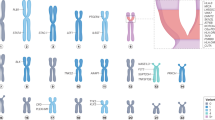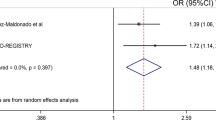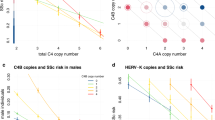Abstract
The objective of this study was to study genetic factors that influence quantitative anticyclic citrullinated peptide (anti-CCP) antibody levels in RA patients. We carried out a genome-wide association study (GWAS) meta-analysis using 1975 anti-CCP+ RA patients from three large cohorts, the Brigham Rheumatoid Arthritis Sequential Study (BRASS), North American Rheumatoid Arthritis Consortium (NARAC) and the Epidemiological Investigation of RA (EIRA). We also carried out a genome-wide complex trait analysis (GCTA) to estimate the heritability of anti-CCP levels. GWAS-meta-analysis showed that anti-CCP levels were most strongly associated with the human leukocyte antigen (HLA) region with a P-value of 2 × 10−11 for rs1980493. There were 112 SNPs in this region that exceeded the genome-wide significance threshold of 5 × 10−8, and all were in linkage disequilibrium (LD) with the HLA- DRB1*03 allele with LD r2 in the range of 0.25–0.88. Suggestive novel associations outside of the HLA region were also observed for rs8063248 (near the GP2 gene) with a P-value of 3 × 10−7. None of the known RA risk alleles (∼52 loci) were associated with anti-CCP level. Heritability analysis estimated that 44% of anti-CCP variation was attributable to genetic factors captured by GWAS variants. In summary, anti-CCP level is a heritable trait, and HLA-DR3 and GP2 are associated with lower anti-CCP levels.
This is a preview of subscription content, access via your institution
Access options
Subscribe to this journal
Receive 6 digital issues and online access to articles
$119.00 per year
only $19.83 per issue
Buy this article
- Purchase on Springer Link
- Instant access to full article PDF
Prices may be subject to local taxes which are calculated during checkout





Similar content being viewed by others
References
Syversen SW, Gaarder PI, Goll GL, Odegard S, Haavardsholm EA, Mowinckel P et al. High anti-cyclic citrullinated peptide levels and an algorithm of four variables predict radiographic progression in patients with rheumatoid arthritis: results from a 10-year longitudinal study. Ann Rheum Dis 2008; 67: 212–217.
Riedemann JP, Munoz S, Kavanaugh A . The use of second generation anti-CCP antibody (anti-CCP2) testing in rheumatoid arthritis—a systematic review. Clin Exp Rheumatol 2005; 23 (5 Suppl 39): S69–S76.
Syversen SW, Goll GL, van der Heijde D, Landewe R, Lie BA, Odegard S et al. Prediction of radiographic progression in rheumatoid arthritis and the role of antibodies against mutated citrullinated vimentin: results from a 10-year prospective study. Ann Rheum Dis 2010; 69: 345–351.
Im CH, Kang EH, Ryu HJ, Lee JH, Lee EY, Lee YJ et al. Anti-cyclic citrullinated peptide antibody is associated with radiographic erosion in rheumatoid arthritis independently of shared epitope status. Rheumatol Int 2009; 29: 251–256.
Turesson C, Jacobsson LT, Sturfelt G, Matteson EL, Mathsson L, Ronnelid J . Rheumatoid factor and antibodies to cyclic citrullinated peptides are associated with severe extra-articular manifestations in rheumatoid arthritis. Ann Rheum Dis 2007; 66: 59–64.
Mjaavatten MD, van der Heijde D, Uhlig T, Haugen AJ, Nygaard H, Sidenvall G et al. The likelihood of persistent arthritis increases with the level of anti-citrullinated peptide antibody and immunoglobulin M rheumatoid factor: a longitudinal study of 376 patients with very early undifferentiated arthritis. Arthritis Res Ther 2010; 12: R76.
Ibn Yacoub Y, Amine B, Laatiris A, Hajjaj-Hassouni N . Rheumatoid factor and antibodies against citrullinated peptides in Moroccan patients with rheumatoid arthritis: association with disease parameters and quality of life. Clin Rheumatol 2012; 31: 329–334.
Montes A, Perez-Pampin E, Calaza M, Gomez-Reino JJ, Gonzalez A . Association of anti-citrullinated vimentin and anti-citrullinated alpha-enolase antibodies with subsets of rheumatoid arthritis. Arthritis Rheum 2012; 64: 3102–3110.
Lundberg K, Bengtsson C, Kharlamova N, Reed E, Jiang X, Kallberg H et al. Genetic and environmental determinants for disease risk in subsets of rheumatoid arthritis defined by the anticitrullinated protein/peptide antibody fine specificity profile. Ann Rheum Dis 2012; 72: 652–658.
Snir O, Widhe M, von Spee C, Lindberg J, Padyukov L, Lundberg K et al. Multiple antibody reactivities to citrullinated antigens in sera from patients with rheumatoid arthritis: association with HLA-DRB1 alleles. Ann Rheum Dis 2009; 68: 736–743.
van de Stadt LA, de Koning MH, van de Stadt RJ, Wolbink G, Dijkmans BA, Hamann D et al. Development of the anti-citrullinated protein antibody repertoire prior to the onset of rheumatoid arthritis. Arthritis Rheum 2011; 63: 3226–3233.
Sokolove J, Bromberg R, Deane K, Lahey L, Derber L, Chandra P et al. Autoantibody epitope spreading in the pre-clinical phase predicts progression to rheumatoid arthritis. PLoS One 2012; 5: e35296.
Arkema EV GB, Robinson WH, Cramb C, Sokolove J, Cui J, Malspeis S et al. Anti-ctrullinated peptide autoantibodies to rheumatoid synovium epitopes in women and risk of future rheumatoid arthritis. Arthritis Res Ther 2013; 15: R159.
Stahl EA, Wegmann D, Trynka G, Gutierrez-Achury J, Do R, Voight BF et al. Bayesian inference analyses of the polygenic architecture of rheumatoid arthritis. Nature Genet 2012; 44: 483–489.
Irigoyen P, Lee AT, Wener MH, Li W, Kern M, Batliwalla F et al. Regulation of anti-cyclic citrullinated peptide antibodies in rheumatoid arthritis: contrasting effects of HLA-DR3 and the shared epitope alleles. Arthritis Rheum 2005; 52: 3813–3818.
van Gaalen FA, van Aken J, Huizinga TW, Schreuder GM, Breedveld FC, Zanelli E et al. Association between HLA class II genes and autoantibodies to cyclic citrullinated peptides (CCPs) influences the severity of rheumatoid arthritis. Arthritis Rheum 2004; 50: 2113–2121.
Cha S, Choi CB, Han TU, Kang CP, Kang C, Bae SC . Association of anti-cyclic citrullinated peptide antibody levels with PADI4 haplotypes in early rheumatoid arthritis and with shared epitope alleles in very late rheumatoid arthritis. Arthritis Rheum 2007; 56: 1454–1463.
Bang SY, Lee HS, Lee KW, Bae SC . Interaction of HLA-DRB1*09:01 and *04:05 with smoking suggests distinctive mechanisms of rheumatoid arthritis susceptibility beyond the shared epitope. J Rheumatol; 40: 1054–1062.
Stahl EA, Raychaudhuri S, Remmers EF, Xie G, Eyre S, Thomson BP et al. Genome-wide association study meta-analysis identifies seven new rheumatoid arthritis risk loci. Nature Genet 2010; 42: 508–514.
Raychaudhuri S, Remmers EF, Lee AT, Hackett R, Guiducci C, Burtt NP et al. Common variants at CD40 and other loci confer risk of rheumatoid arthritis. Nature Genet 2008; 40: 1216–1223.
Raychaudhuri S, Thomson BP, Remmers EF, Eyre S, Hinks A, Guiducci C et al. Genetic variants at CD28, PRDM1 and CD2/CD58 are associated with rheumatoid arthritis risk. Nature Genet 2009; 41: 1313–1318.
Okada Y, Terao C, Ikari K, Kochi Y, Ohmura K, Suzuki A et al. Meta-analysis identifies nine new loci associated with rheumatoid arthritis in the Japanese population. Nature Genet 2012; 44: 511–516.
Zhernakova A, Stahl EA, Trynka G, Raychaudhuri S, Festen EA, Franke L et al. Meta-analysis of genome-wide association studies in celiac disease and rheumatoid arthritis identifies fourteen non-HLA shared loci. PLoS Genet 2011; 7: e1002004.
Cui J, Taylor KE, Destefano AL, Criswell LA, Izmailova ES, Parker A et al. Genome-wide association study of determinants of anti-cyclic citrullinated peptide antibody titer in adults with rheumatoid arthritis. Mol Med 2009; 15: 136–143.
Roggenbuck D, Reinhold D, Wex T, Goihl A, von Arnim U, Malfertheiner P et al. Autoantibodies to GP2, the major zymogen granule membrane glycoprotein, are new markers in Crohn's disease. Clin Chim Acta 2011; 412: 718–724.
Eyre S, Bowes J, Diogo D, Lee A, Barton A, Martin P et al. High-density genetic mapping identifies new susceptibility loci for rheumatoid arthritis. Nature Genet 2013; 44: 1336–1340.
Raychaudhuri S, Sandor C, Stahl EA, Freudenberg J, Lee HS, Jia X et al. Five amino acids in three HLA proteins explain most of the association between MHC and seropositive rheumatoid arthritis. Nature Genet 2012; 44: 291–296.
Dias JM, Kuehne AI, Abelson DM, Bale S, Wong AC, Halfmann P et al. A shared structural solution for neutralizing ebolaviruses. Nature Struct Mol Biol 2011; 18: 1424–1427.
Mooyaart AL, Valk EJ, van Es LA, Bruijn JA, de Heer E, Freedman BI et al. Genetic associations in diabetic nephropathy: a meta-analysis. Diabetologia 2011; 54: 544–553.
Garner CP, Murray JA, Ding YC, Tien Z, van Heel DA, Neuhausen SL . Replication of celiac disease UK genome-wide association study results in a US population. Hum Mol Genet 2009; 18: 4219–4225.
Jodon de Villeroche V, Avouac J, Ponceau A, Ruiz B, Kahan A, Boileau C et al. Enhanced late-outgrowth circulating endothelial progenitor cell levels in rheumatoid arthritis and correlation with disease activity. Arthritis Res Ther 2010; 12: R27.
Caprini E, Cristofoletti C, Arcelli D, Fadda P, Citterich MH, Sampogna F et al. Identification of key regions and genes important in the pathogenesis of sezary syndrome by combining genomic and expression microarrays. Cancer Res 2009; 69: 8438–8446.
Plenge RM, Seielstad M, Padyukov L, Lee AT, Remmers EF, Ding B et al. TRAF1-C5 as a risk locus for rheumatoid arthritis—a genomewide study. N Engl J Med 2007; 357: 1199–1209.
Karlson EW, Chibnik LB, Cui J, Plenge RM, Glass RJ, Maher NE et al. Associations between human leukocyte antigen, PTPN22, CTLA4 genotypes and rheumatoid arthritis phenotypes of autoantibody status, age at diagnosis and erosions in a large cohort study. Ann Rheum Dis 2008; 67: 358–363.
Whiting PF, Smidt N, Sterne JA, Harbord R, Burton A, Burke M et al. Systematic review: accuracy of anti-citrullinated Peptide antibodies for diagnosing rheumatoid arthritis. Ann Intern Med 2010; 1527: W155–W166.
Ioan-Facsinay A, el-Bannoudi H, Scherer HU, van der Woude D, Menard HA, Lora M et al. Anti-cyclic citrullinated peptide antibodies are a collection of anti-citrullinated protein antibodies and contain overlapping and non-overlapping reactivities. Ann Rheum Dis 2011; 70: 188–193.
Sokolove J BR, Bromberg R, Deane KD, Lahey LJ, Derber LA, Chandra PE et al. Autoantibody epitope spreading in the pre-clinical phase predicts progression to rheumatoid arthritis. PLoS One 2012; 5: e35296.
Shadick NA, Heller JE, Weinblatt ME, Maher NE, Cui J, Ginsburg G et al. Opposing effects of the D70 mutation and the shared epitope in HLA-DR4 on disease activity and certain disease phenotypes in rheumatoid arthritis. Ann Rheum Dis 2007; 66: 1497–1502.
Padyukov L, Silva C, Stolt P, Alfredsson L, Klareskog L . A gene-environment interaction between smoking and shared epitope genes in HLA-DR provides a high risk of seropositive rheumatoid arthritis. Arthritis Rheum 2004; 50: 3085–3092.
Purcell S, Neale B, Todd-Brown K, Thomas L, Ferreira MA, Bender D et al. PLINK: a tool set for whole-genome association and population-based linkage analyses. Am J Hum Genet 2007; 81: 559–575.
Price AL, Patterson NJ, Plenge RM, Weinblatt ME, Shadick NA, Reich D . Principal components analysis corrects for stratification in genome-wide association studies. Nature Genet 2006; 38: 904–909.
Marchini J, Howie B, Myers S, McVean G, Donnelly P . A new multipoint method for genome-wide association studies by imputation of genotypes. Nat Genet 2007; 39: 906–913.
Jia X, Han B, Onengut-Gumuscu S, Chen WM, Concannon PJ, Rich SS et al. Imputing amino acid polymorphisms in human leukocyte antigens. PLoS One 2013; 8: e64683.
Purcell SM, Wray NR, Stone JL, Visscher PM, O'Donovan MC, Sullivan PF et al. Common polygenic variation contributes to risk of schizophrenia and bipolar disorder. Nature 2009; 460: 748–752.
Yang J, Benyamin B, McEvoy BP, Gordon S, Henders AK, Nyholt DR et al. Common SNPs explain a large proportion of the heritability for human height. Nature Genet 2010; 42: 565–569.
Author information
Authors and Affiliations
Corresponding author
Ethics declarations
Competing interests
The authors declare no conflict of interest.
Additional information
Supplementary Information accompanies this paper on Genes and Immunity website
Supplementary information
Rights and permissions
About this article
Cite this article
Cui, J., Taylor, K., Lee, Y. et al. The influence of polygenic risk scores on heritability of anti-CCP level in RA. Genes Immun 15, 107–114 (2014). https://doi.org/10.1038/gene.2013.68
Received:
Revised:
Accepted:
Published:
Issue Date:
DOI: https://doi.org/10.1038/gene.2013.68
Keywords
This article is cited by
-
Genome-wide exploratory analysis for NARAC dataset with preparation for haplotype block partitioning through minor allele frequency quality control viewpoint
Iran Journal of Computer Science (2023)
-
Rationale and Design of the Brigham Cohort for psoriasis and psoriatic arthritis registry (COPPAR)
BMC Dermatology (2017)



